In 1980 I was managing Taste Records in High Street, had a new record label, Propeller, and a friendship with Rip It Up’s Murray Cammick. My first handful of records were by bands who either were part of the early punk era (Marching Girls, formerly The Scavengers) or had evolved from the Zwines bands (The Spelling Mistakes, The Features, Techtones). But – either because of breakups or emigration – I found myself heading towards the end of the year with no bands on the label.
Instinctively, I started looking at, and actively following, the new bands filling the underage venues and the multitude of new pub venues around the city; the bands inspired by punk, not part of it. There was no shortage of talent: a swarm of bands who’d arrived from the North Shore that I was seeing and liking most weekends, plus the ska-soul-ish Newmatics and Rhythm Method from the city side (and a trio about to name themselves Blam Blam Blam who also came from the North Shore but from an earlier era). The precursor to the Blams, The Whizz Kids, was an oft-named influence on the new Shore bands with Yoh telling me that “… seeing the Whizz Kids perform at a Westlake Boys High School dance was an inspiration to be in a band”.

Terence Hogan's poster for the Class Of 81 compilation of new bands, released in March 1981.
I came up with the idea to put together a collection of these new post-punk bands then sign the best two or three to the label, the plan being that I’d somehow build the album around these bands and follow it with singles from each. I used the idea to sell myself to Festival Records and get a distribution deal that would solve my getting-records-into-stores problems. So, with Murray Cammick’s assistance, I put notices in Taste Records and Record Warehouse in October 1980, followed by a mention in the Auckland Rip It Up rumours column in November, asking for new bands to send me tapes. The Rip It Up mention not only gave the record a name – Class of 81, suggested by The Spelling Mistakes’ Nigel Russell – but said the Screaming Meemees and Blams were likely contenders, which was true as I’d already agreed to sign both bands. I hoped to get the Newmatics as well, and possibly another of the North Shore bands, likely the post-punk-ish Rebel Truce.
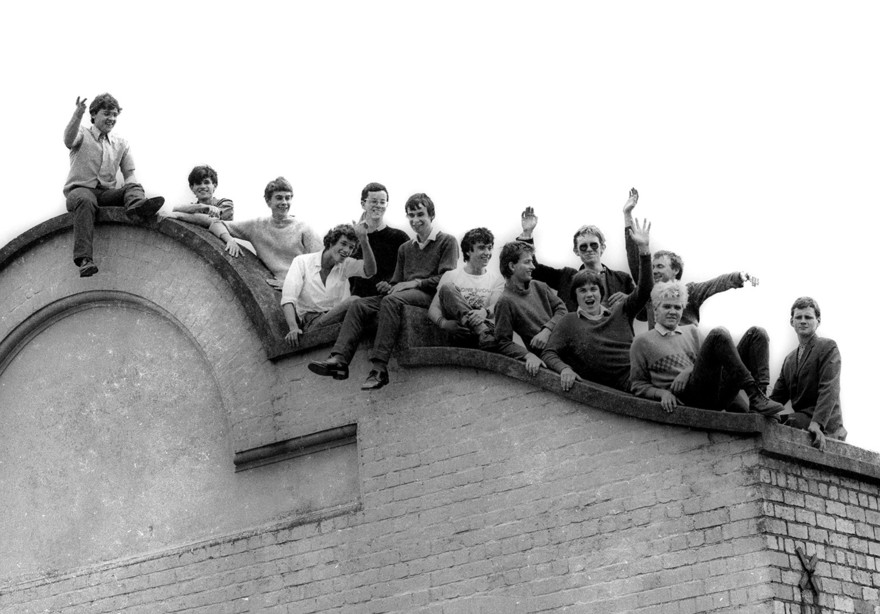
Class of '81 bands on the roof of XS Café, Airedale St, Auckland. - Anthony Phelps
The response was immediate. Harlequin Recording Studios had a midnight-to-dawn rate of $25 an hour on offer, and I was swamped by keen young men and women hanging around the counter at Taste Records, including the ever-present Hilary Hunt, whom I quickly grew to like. Hilary had tapes and that meant I also had tapes: The Killjoys, Rebel Truce, The Ainsworths and a five-track demo from The Screaming Meemees were on my desk.
“When Hils and I fronted up at the record shop you worked at, to give you a copy of our cassette entry for Class of 81,” says Rowan Shedden, “I wasn’t too sure it would make the cut and I didn’t know who you were. There were four songs on it and ‘Danger Man’ was the one chosen ... getting onto a record was pretty special.”
By the end of the year, I had most of a compilation and was spending most weekends with the bands at XS and elsewhere, eventually doing lights and sound (something I knew little about, so I was in good company as they didn’t seem to know much more) on occasion. Then there were the ongoing football and cricket games at the Auckland Domain, where half the Shore seemed to form a team to play the cityside bands with some 40 on the field at any time. This bonded everyone, forming friendships that survive today.
The Screaming Meemees appeared to have found a manager too. It was never exactly clear what David Merritt did apart from express great enthusiasm, but Yoh suggests it was because, “Mike’s oldest sister Erin flatted with Dave, he was involved with the uni student union and had experience organising events and also some contacts in the city, so he seemed like a good progression for us. Even if he was considered a hippie.”
Class of 81 was scheduled for release in February of the new year. With David Merritt as manager, the Meemees were playing several times a week, both on the Shore and in the city and pulling increasing crowds. As Mark Phillips said in Rip It Up, when they played, they were always the “main event”. They played the XS Café North Shore Band Spectacular on 13 December with The Killjoys, Regulators, Rebel Truce and The Ainsworths, and twice that month at The Windsor Castle. There were gigs at The Rumba Bar and The Reverb Room (Liberty Stage renamed to try and tone down the violence that plagued it) and a trip to Wellington in early December where they played at The Last Resort with Shoes This High and The Mockers. They also appeared on Hauraki Homegrown Eighty, a middling, mostly mainstream collection put together by the Auckland radio station, released without much enthusiasm by Bryan Staff’s Ripper label. The Screaming Meemees vibrant ‘See Me Go’, taken from the demos, was reviewed as the best track on it by Mark Phillips in January 1981.

Class of 81 (Propeller, 1981)
The Killjoys, Regulators and Meemees were back at XS mid-month, promoted with a poster that used one of a series of North Shore band photos taken by Anthony Phelps in December, taken in and around XS along with a photo of the Meemees in the railway yards near Parnell. The photos had also appeared in the Sunday News, when writer Al Campbell, or at least his sub-editor, had casually used the term North Shore Invasion, which was the first time it seems to have appeared in print.
In January I finally signed the Screaming Meemees to a long-term deal and, mostly via Dave Merritt, all sorts of ideas flowed freely. At one stage I was called into Festival Records to adjudicate a request for a submarine for a video for a (yet to be decided) debut single.
The original idea for the debut was a live EP, probably headed by ‘Till I Die’, a song adapted from a Catholic hymn [‘We Are One in the Spirit’] that stomped infectiously as the lead track but we quickly decided that a better call would be the demo of the live favourite ‘See Me Go’ (although it was on the Hauraki album). In late February the quartet entered Harlequin Studios with Andrew Snoid ( Andrew McLennan – ex-Whizz Kids and current vocalist in Pop Mechanix) in the producer’s chair with Steve Kennedy, who had recorded the earlier demos as engineer (he recorded almost all the earlier North Shore demos that found their way to Class of 81). It was the beginning of a long, laborious and perhaps unnecessary process and none of these early sessions made the final cut. In early 1981 Hilary Hunt formed his own record label, Olympic Presentations, and announced via Rip It Up that he was going to release a three-single pack with The Ainsworths, The Killjoys and The Regulators. I also had a new partner in Propeller, with Paul Rose.
As a one-off for Ripper, Screaming Meemees recorded another track, ‘Can’t Take It’, at Harlequin (produced by Steve Kennedy) on February 2; Peter Van Der Fluit’s keyboard intro was the theme of the new after-school TV show A Dropa Kulture. A now-lost video was filmed at the Shortland Street TVNZ Studios later that month and the song was finally issued as a single (paired with the Newmatics’ ‘Judas’) in mid-March. It charted at a respectable No.37 for two weeks, and continual sales pushed it back into the charts a month later; it hovered just outside the chart for much of the rest of the year courtesy of a weekly TV plug.
We slowly leaked a few of the tracks from Class Of 81 to student radio in February and both The Ainsworths’ jaunty ‘Danger Man’ and The Killjoys ska-ish proclamation ‘I’m Normal’ topped the Radio B Top 10 that month, followed by the Meemees’ more considered ‘All Dressed Up’ and Rebel Truce’s punky anthem, ‘Man Next Door’. When Class of 81 was finally issued (late because of a rejected sleeve and normal indie woes) on 13 March 1981, we had six of the station’s Top 10 (Blam Blam Blam’s ‘Motivation’ and the Newmatics’ ‘Five Miseries’ had joined the others) and the album entered the New Zealand compilation charts the next week at No.1, where it sat for three weeks.
It was the right album at the right time and defined a moment, with that definition being provided in a large part by the bands that had come across the bridge just a few months earlier. “When Class of 81 was released, Auckland was in the middle of a mod boom and many of the bands wore that badge on their sleeves at the time,” recalls Adam Holt.
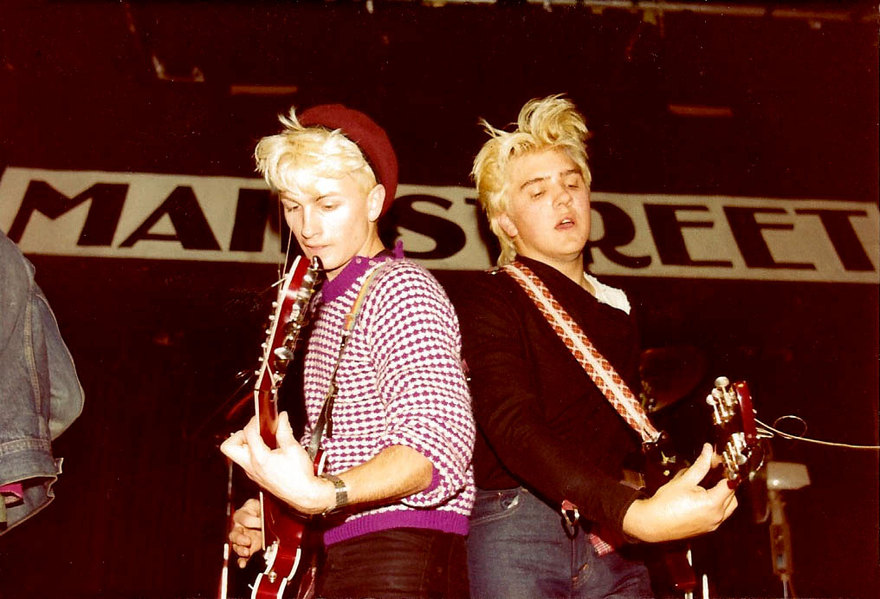
Adam Holt playing with The Screaming Meemees, Mainstreet, Auckland, 1982
It was a boom that seemed to reverberate city-wide too, with new mod-ish combos being listed in the gig guides weekly, with names like The Blue Asthmatics, Instigators and The Corners. That summer and autumn Queen Street and Vulcan Lane were like an extension of the Shore, with cherry-red Doc Martens boots, Union Jacks on everything, and red kerchiefs.
Two gigs defined the brief scene that month, the first being on Wednesday, March 11 at Mainstreet, when The Ainsworths, Screaming Meemees, Newmatics, Rhythm Method and Blam Blam Blam filled Queen Street’s the prestigious cabaret to capacity to launch the Class Of 81. The gig was also broadcast in its entirety on Radio B; it was the first time the station had done so, using new lines installed for the purpose by the Post Office.
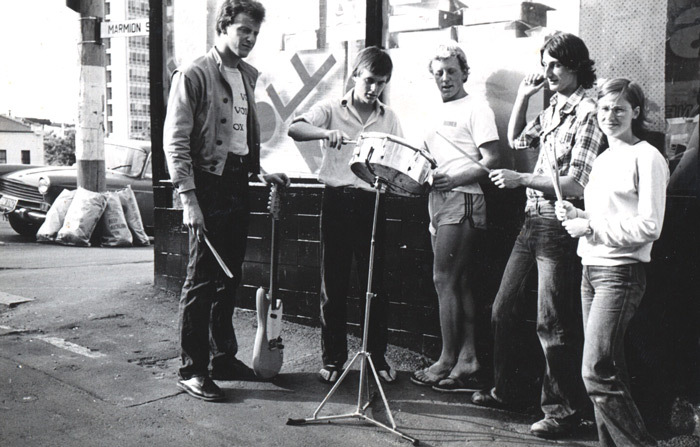
Rhythm Method outside Rock'n'Roll Records, Queen Street, 1981
On the 27th, in what would be one of the final North Shore scene gigs, Rebel Truce, The Killjoys and the Meemees played a similarly filled North Shore Netball Club in Northcote. The event was captured by Murray Cammick in a series of photos that include some with the police shutting down the venue over noise complaints and concerns over violence; given the age and nature of the crowd, this was absurd. It was the week I’d also been asked to manage the Meemees, with Michael O’Neill telling me they would split if I declined. I had little choice.

The Screaming Meemees, North Shore Netball Club, 27 March, 1981 - Photo by Murray Cammick
Sessions for ‘See Me Go’ continued and we were not happy. It was scheduled for May then June release, but somehow the recordings failed to capture the raw essence of the 1980 demo. Studio owner Doug Rogers, who had taken over engineering the sessions, offered to step in and record a third version, for, we were promised, no extra cost. The recording process continued, unenthusiastically. Everyone was over the song.
The recordings were interrupted by an extended Class of 81 trek south by The Newmatics and The Screaming Meemees. In Wellington they played The Last Resort, and in Christchurch The Gladstone and Canterbury University. The trip culminated with an Easter Monday show that also featured The Newtones, the only Christchurch band on the Class of 81. Before they left, The Screaming Meemees again filled Mainstreet, another show that was recorded, which gave us one more possible track for the debut Propeller EP. The live favourite ‘Pointy Ears’ dated to the band’s earliest attempts to write and would only ever really work as a live recording.
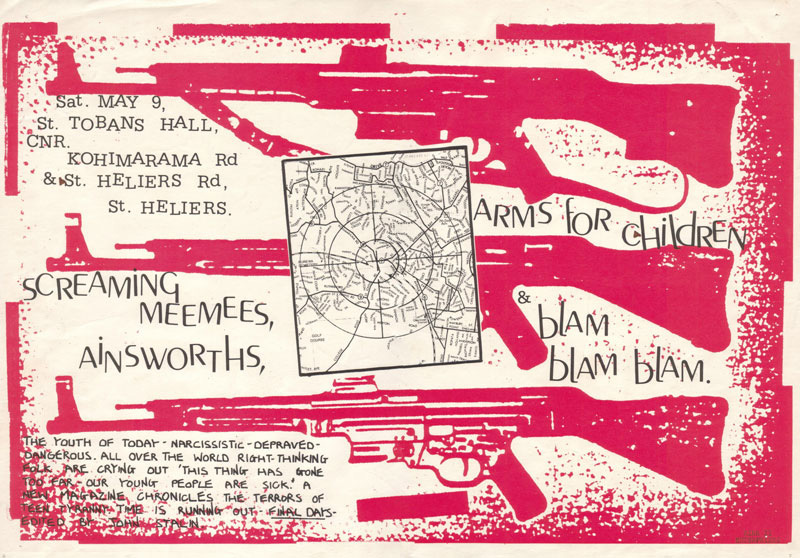
A May 1981 poster for "North Shore Invasion" bands in Kohimarama, Auckland, with The Screaming Meemees, Blam Blam Blam, Alms For Children and The Ainsworths - Simon Grigg Collection
On May 9, the North Shore Invasion went east, and The Ainsworths, Meemees, Alms For Children and Blam Blam Blam filled another church hall, this time St Toban’s in distant St Heliers. Again the police decided it was undesirable and shut it down during the final set from Alms, leaving a bunch of dissatisfied but essentially harmless North Shore teens roaming the eastern suburbs. Both Hilary and I pleaded with the cops to simply let it finish but the squad from nearby Glen Innes wanted no part of these threatening kids in Doc Martens. “We want no trouble,” the sergeant warned me, as he created it.
The Ainsworths and The Regulators released their single in June, down from a triple pack to a double A-sided 45. It was well received and via our Propeller mail order service we sold a bunch, complicated a little by the fact the sides (‘Coin’ and ‘Neat Boy’ respectively) were reversed at the pressing plant, although both were marked on the release as B-sides. Steve Kennedy recorded the first and Doug Rogers the other, both at Harlequin.
The sessions for the ‘See Me Go’ EP seemed endless, but regardless of that it now seemed to have a life of its own. The success of the band meant there was a growing demand for the record. The Screaming Meemees, six months after they were playing XS Café as part of a mixed band line-up, were now filling the biggest venue in the inner city, Mainstreet Cabaret, with crowds for their monthly shows approaching 1000 some nights. A frenzy was growing around the impending 45. I decided to do two versions, a four-track EP on a 12" (in a numbered edition, limited to 500), and a 7" two-track single, unlimited, with the title track and a studio take of ‘Till I Die’. Record stores began to take orders for the 12" and it was quickly obvious we’d underestimated demand, with the 500 all pre-sold by mid-June, complicated by the fact we had now decided to delay it once more for a final mix.
July that year was a particularly cold, miserable one as I recall it, although maybe that was accentuated by the miserable events that month with the Springbok tour and New Zealand erupting into a nationwide physical and verbal brawl. As part of the Screaming Blam-matic Roadshow, The Screaming Meemees, possibly the least political band in the country, followed the tour around and in Wellington found themselves being beaten up, not because of their politics but because the capital’s skinheads decided they didn’t like any of us. The Auckland skins, who long ago had adopted the North Shore bands as their own, were not on hand to protect.
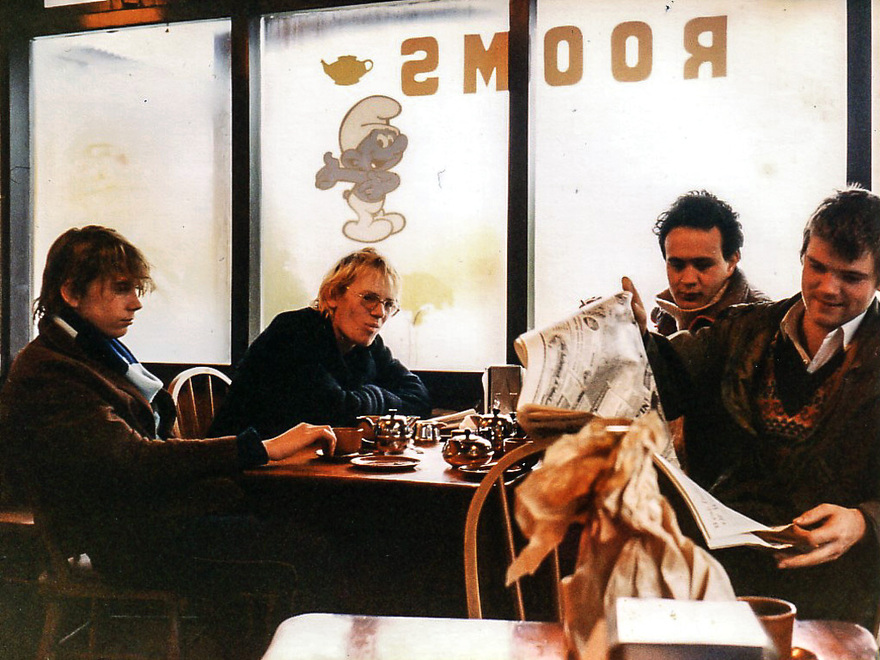
Screaming Blam-matics on tour - Peter van der Fluit and Yoh (Screaming Meemees) with David Rudolph and Tim Mahon (Blam Blam Blam) - Photo by Jenny Pullar
In Christchurch, the Auckland band told the local media that they didn’t rate the new single, ‘See Me Go’, which resulted in Festival Records calling me and berating me for the as-yet unreleased nor pressed 45. It mattered little as stores had already pre-sold all 500 12"s and a couple of thousand of the 7"s. The band simply meant that the song was representative of where they were a few months earlier. They’d moved on and rarely even played the song live anymore, despite my entreaties as both record label and band manager.
I had also made the decision, though, to delete the 7" 45 on release week and the band agreed, however I doubt they cared either way. Also, while in Christchurch, the test pressing of the 7" arrived by courier for approval. Horrified, we discovered that the song had been remixed yet again, by the marketing guy at Festival without our authority or knowledge. It was an awful, muffled mess, resolved only by me calling Nigel Wilkinson, the production manager in Auckland, and getting him to urgently recut the 45 at Harlequin with the agreed final mix. The guy from Festival didn’t seem to ever notice, but it pushed the release back another week.
See Me Gone
I’m always amazed when people seem able to remember exactly what they were doing on a certain date decades before. That said, I can tell you exactly what I was doing on 27 August 1981. More than that, I can tell you how I was feeling and even remember some of the conversations I had, almost word for word. Why? That was the day The Screaming Meemees’ ‘See Me Go’ went into the New Zealand Singles chart, entering at No.1.
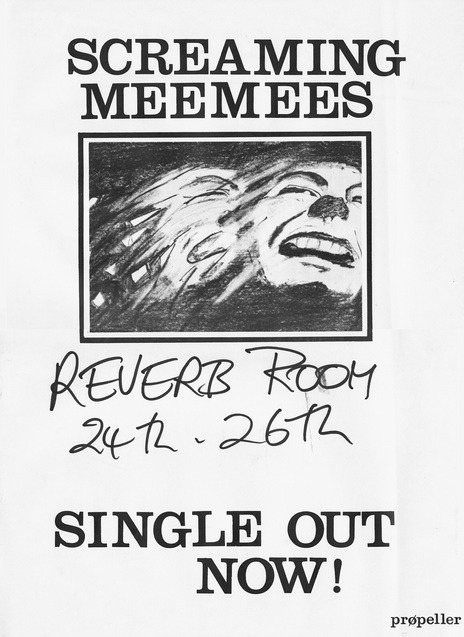
The July 1981 poster for the See Me Go single - the first New Zealand single to enter the chart at No.1. - Art by Tony Drumm. Scrawl by Simon Grigg.
It was the first time any local record had done that (it sold four times the No.2 single, we were told) and it had done so without any commercial radio airplay whatsoever. After we got the call at the Propeller Records office, there was an initial “who cares” which quickly devolved into grins, a whoop around the office and then silence, staring at each other. The band left to gather with friends at the Sounds Unlimited record shop in Queen Street. I first rang my girlfriend, followed by Murray Cammick, and then Paul Rose and I went to Festival for a celebratory drink. At Festival, Ray Porter, the company’s managing director called me into his office and asked if we could quickly record a live album (“where are they playing this weekend?”) to rush-release, with the single added. I declined (Paul agreed), but also understood that this was both the peak and probably the beginning of the end of the North Shore Invasion of the Auckland band scene.
By August 1981 the bands had mostly gone: broken up or simply drifted away. What was a few weeks earlier a focal point in Auckland music seemed to dissipate faster than it had arrived, lacking even breakup notices in Rip It Up’s Rumours or the Auckland Star. Tastes changed rapidly in those tumultuous 18 months and the influences of The Undertones and 60s pop were replaced by The Fall and DIY in a matter of months. XS and Squeeze had both closed and the pubs were reeling from skinhead violence, stepping back from bands that may have had that following.
The one North Shore band that survived was Alms For Children, whose style was probably closer to the city’s post-punk evolution towards lo-fi and away from indie pop. Their three-track EP was issued on Rip It Up columnist Harry Ratbag’s new REM label in early August, charted at No.48 two weeks before ‘See Me Go’. After regrouping as This Sporting Life, they continued until late 1983. The Ainsworths’ Rowan Shedden formed The Dabs with The Regulators’ Geoff Hayden and Steve Thorpe; The Regulators’ Andrew Boak formed No Tag with The Flicks’ Mark Sullivan and Paul and Carl Van Wetering, and Adam Holt eventually joined goth-rockers Sons In Jeopardy. These days Adam is the chairman of Universal Music New Zealand, a director of Recorded Music New Zealand and has played a major role in the careers of OMC, Lorde and Benee, among many others. Hilary Hunt left the music business and moved into currency trading where he applied similar skills with substantial success over the years.

Sons In Jeopardy (L-R): Paul Cairns, Wayne Flintham, Adam Holt, Andrew Bishop, Paul Masja. - Murray Cammick Collection
The Screaming Meemees stayed together for another 18 months, during which time they were one of the biggest live draws in New Zealand. They split up after a Saturday night headlining slot at Sweetwaters 1983, and the release of what many think was their best record, ‘Stars in My Eyes’, an extended 12" club record that was a lifetime away from those early demos.
Along the way they also recorded an album, If This is Paradise, I’ll Take The Bag, the tumultuous sessions for which were probably the final scene in the North Shore Invasion story. Night after night, many of the players and friends – who had first formed bands or followed them around the North Shore and across the Harbour Bridge – gathered in Harlequin Studios, turning the sessions into an extended (and expensive) party. This was totally appropriate, as it was pretty much how the scene began: a bunch of close-knit friends having fun.
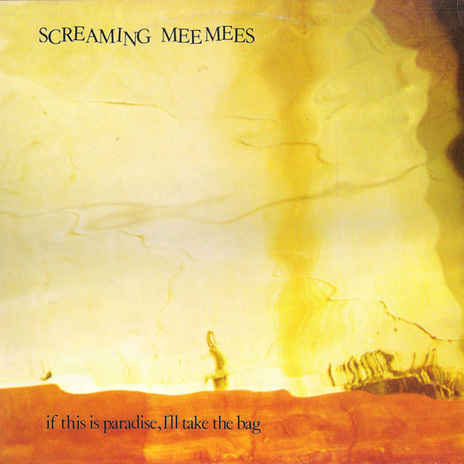
If This Is Paradise, I'll Take The Bag, the July 1982 album produced by Ian Morris that took the Meemees on a path away from the early ska flavoured power-pop. It was heavily praised by US and UK media but confused some of the earlier fanbase in New Zealand.
Adam Holt remembers it “being a continuation of our scene – instead of all meeting at Michael’s house like we normally did, we decamped to Harlequin for the duration of the Meemees album sessions. Naively, we never gave a thought about what was going on there or how much a studio cost on a daily basis. Family and friends was hugely important to the whole scene, and where the Meemees went, we followed.”
For the band itself, as Yoh says, it was a support group; for example, everyone did backing vocals in the chorus of ‘Sunday Boys’. The Meemees would never have gotten that far (recording an album) without their support. “As a band we were collectively and individually too sensitive and insecure to achieve what we did without a large group of supporters,” he says.
However, by then it was almost another band, musically more adventurous and drawing disparate influences from places that, earlier, the Meemees would not have entertained.
Adam Holt: “It was [Mark Phillips’ and Peter Urlich’s] A Certain Bar that really ended the 1981 North Shore band scene – we saw something even more exciting going on and the whole gang shifted en masse, onto the dancefloor. That’s a whole other story.”
The best place to hear those short years may be in the grooves of two live recordings, ‘Pointy Ears’ (originally on a Ripper sampler) and ‘Poison Boys’ (a bonus track on the 12" EP of ‘See Me Go’) which show just how joyously irreverent all these North Shore garage bands were live – and exactly why they attracted often thousands of energic fans week after week for two years, kids who just wanted to dance to their mates.
And in the end …
Andrew Boak: “The legacy? That a scene can generate itself naturally when there are enough individuals who work together for a common goal. We created an outlet for our own creativity, whilst creating our own underage gigs for entertainment, because there was nowhere else to go, except the damn disco ... Because of our naivety, some bands made good decisions, others didn’t, however it showed that you could just pick up a guitar with like-minded people of your age, and just go for it.”
Adam Holt: “Friendship, lifelong relationships, children, and the most incredible memories. It was the most well-spent youth: creative, mildly rebellious and fun. The musical legacy may only be a tiny footnote in the history of New Zealand music, but it’s a scene where everything started for us all. Its where we grew up as people. Our relationships were deeply entwined, and the social connection was as important, if not more important, to us than the bands we were in.”
Yoh: “We grew up and grew apart. We were from a safe but boring place, we were naive to the social pressures that existed in other places and I think that innocence helped to bond us. It was never an ‘us against the world’ kind of thing, [but] the group effort helped us achieve our success.”
--